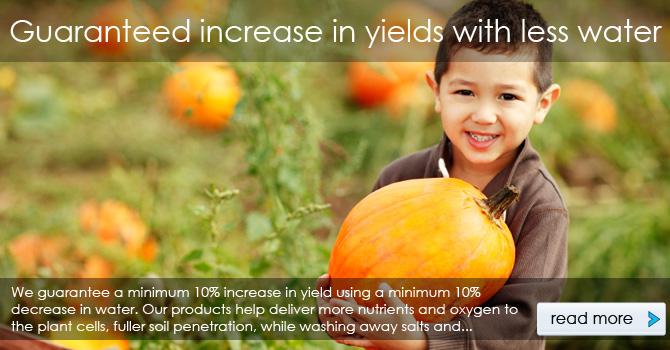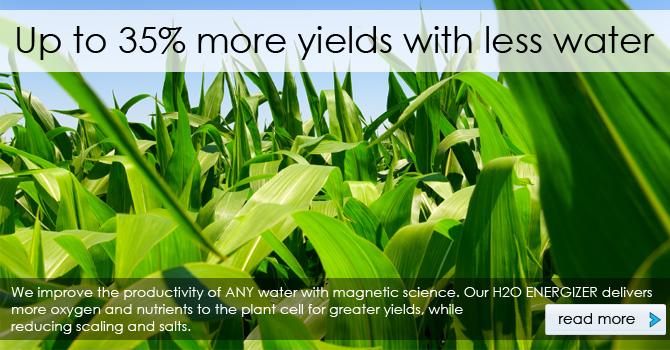Request more information
Horticulture
It is known that plants and trees need mineral salts and microelements from the soil to function and photosynthesize properly. However, plants do not use the majority of nutrients that are in soil. While watering plants with normal water, only a small amount of nutritional elements dissolves in the soil and becomes available to the plants. Further consumption of these nutrients from the soil is very rare when plants start to grow and a larger amount of nutrients is required, the deficit of microelements results in low numbers of crop. The deficit of microelements/nutrients in the soil is the main reason for a decreased growth rate and low crop. That is the reason to why magnetic water should be used for irrigation.
In addition, when the plant is watered using hard and non- magnetized water, white coating is formed on the surface of the soil: that is calcium bicarbonate and carbonate. Some of calcium bicarbonate is washed away by water penetrating soil and depositing on the roots of plants. The plant, then, starts to suffocate because of these depositions and in order to continue to feed, forms additional roots. This process results in a decrease of normal growth in plants.
However, plants that are irrigated using water that is treated by "Magnetic Technologies" company, easily take in mineral salts from the soil and no sediment is formed on the soil surface. Also if mineral and organic fertilizers are used, they dissolve better which results in their need for use the decrease by 50% and at the same time, plants still continue to develop without any extra effort. This results in an increased crop production and in an increased quality of agricultural products.
In short, the economic advantage of using magnetic water for irrigating the crops looks like this:
Advantages
- Vegetation period decreases by 15-20 days, therefore the crops ripe 15-20 days earlier than normally.
- Crop production increases from 15-20% to 100%, and in some cases, even more.
- Plant disease rates drastically decrease.
- Taste of agricultural products improves.
- Approximately 30% less water is used for irrigation
- Therefore 30% less energy is used in water pipes.
- Sea water (salty water) can be used for watering (from 6-8 thousand PPM inclusive) and for some cultures, very salty water can be used (from 15 thousand inclusive).
- By magnetizing seeds before sowing and by irrigating them with magnetic water, the need for crop material decreases by min. 30%.
- Average of 30% decrease in fertilizer consumption.
- Active soil desalination takes place, increasing crop production year after year.
Expenses
Expenses that occur during the installment of magnetic systems for 1 hectare of land come up to approximately $750. In addition, our magnetic devices do not need technical maintenance and do not require electrical energy. Life of our devices is min. 25 years. If we divide $750 by 25 years, our expenses will be $30/year. Compare advantages with expenses and draw your own conclusions!
Below, we included reports of various organizations, which use our technology and our devices. These experiments were carried out in different parts of the world, in different climates and on different soil; that gives us the right to say that using magnetic technologies has no limits and limitations when it comes to various conditions and situations.
As we see, the results show that using magnetic water can only be an advantage.
Conditions of experiments
All of the experiments were carried out using the same method. That is a land area was chosen and divided into two equal parts. One part was used as a control and was watered using normal water. The second half had magnetic devices installed. After that, same kinds of seeds were planted in both areas at the same time.
The following changes were recorded:
In plants
Speed of crops' standing.
Percentage of crops standing.
Development of root system.
Difference in green mass.
Development of first flowers.
Development of first fruits.
Quantity of fruits.
Time of collecting the harvest.
Difference in quantity and quality of harvest.
In soil
Amount of salts at different depth of the soil (0-1.5m) before the irrigation process.
Amount of salt in soil while watering with normal and magnetic waters.
Density of water that has flown through the soil.
Speed of filtration in the beginning and at the end.
Washing away of salts while irrigating soil with water.
Washing out of various anions from the soil.
INTERNATIONAL RESEARCH CONFIRMS THE FOLLWOING RESULTS.
The summary of observation result(1)
| Description | Growth per day | Difference | % Increase | % Increase per Plant | |
|---|---|---|---|---|---|
| With Magnetic devices | Without Magnetic devices | ||||
| Corn plant | |||||
| Plant height (cm) | 4.32 | 2.46 | 1.75 times | 75 | 40% |
| Total Leaves (sheet) | 0.42 | 0.38 | 1.11 times | 11 | |
| Length of Leaves (cm) | 3.00 | 2.07 | 1.45 times | 45 | |
| Diameter of Stalk (mm) | 0.11 | 0.08 | 1.30 times | 30 | |
| Onion Plant | |||||
| Plant height (cm) | 0.58 | 0.46 | 1.25 times | 25 | 74% |
| Total Leaves (sheet) | 0.75 | 0.33 | 2.25 times | 125 | |
| Length of Leaves (cm) | 0.53 | 0.30 | 1.75 times | 75 | |
| Diameter of Stalk (mm) | 0.09 | 0.05 | 1.69 times | 69 | |
| Rice Plant | |||||
| Plant height (cm) | 0.34 | 0.23 | 1.45 times | 45 | 72% |
| Total Leaves (sheet) | 2.75 | 1.71 | 1.61 times | 61 | |
| Length of Leaves (cm) | 0.23 | 0.09 | 2.67 times | 167 | |
| Diameter of Stalk (mm) | 0.03 | 0.34 | 1.14 times | 14 | |
| Pumpkin Plant | |||||
| Plant height (cm) | 1.18 | 0.31 | 1.45 times | 45 | 91% |
| Total Leaves (sheet) | 1.00 | 0.50 | 2.00 times | 100 | |
| Length of Leaves (cm) | 0.29 | 0.18 | 1.14 times | 79 | |
| Diameter of Stalk (mm) | 0.05 | 0.02 | 1.45 times | 140 | |
| Cucumber Plant | |||||
| Plant height (cm) | 0.49 | 0.42 | 1.17 times | 17 | 3% |
| Total Leaves (sheet) | 0.25 | 0.21 | 1.20 times | 20 | |
| Length of Leaves (cm) | 0.14 | 0.16 | 0.85 times | -15 | |
| Diameter of Stalk (mm) | 0.05 | 0.05 | 0.92 times | -8 | |
| Broccoli | |||||
| Plant height (cm) | 0.63 | 0.26 | 2.45 times | 145 | 100% |
| Total Leaves (sheet) | 0.33 | 0.25 | 1.33 times | 33 | |
| Length of Leaves (cm) | 0.44 | 0.26 | 1.71 times | 71 | |
| Diameter of Stalk (mm) | |||||


